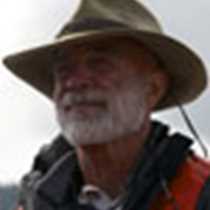It is because of days like today that competition is keen among Lindblad naturalists to work the late-season Baja trips that explore the midriff region of the Sea of Cortez. Our morning began before breakfast, watching a large gathering of brown- and blue-footed boobies plunge-diving like a cascading waterfall into the sea after a huge school of baitfish. After breakfast we went ashore in our Zodiacs to the Seri Indian island of Tiburon for walks in a beautiful and rather lush wash. The results of winter rains were clearly evident in richly blooming Palo Verdes and ocotillos, trumpet flowered daturas and lightly scented flower clusters on the strangely peeley-barked Willard's acacia trees. Flocks of white-crowned sparrows flitted from tree to tree while ravens, red-tailed hawks and an exquisite black-shouldered kite hunted and soared over the arroyo. The ground was literally covered with tracks: coyote, mule deer, mice, birds and lizards. And lizards were everywhere. Gambelia wislizenii, the leopard lizard, was perhaps the most abundant and beautiful of the reptiles we came across and is pictured above. The leopard lizard is among the fastest of lizards, often racing along on its rear legs only, and it is an aggressive predator, eating chiefly other lizards along with large insects. Leopard lizards are unusual in that it is the females that are more colorful and larger than the males. In the spring, as eggs develop inside the female's body, hormones cause orange markings to develop along the sides of her body, which may attract males to mate with her. Whatever the reason for the markings, this female was certainly beautiful and bold enough to allow our close approach.
Once back aboard the Sea Lion, we headed west across the gulf to Isla Rasa, the home of 98% of the world's nesting Heerman's gulls and elegant terns. We had only a short window of time in the late afternoon when our Zodiacs could get in and out of the island's only landing lagoon and the wind was up and out of the wrong direction. The ship sent a Zodiac to pick up Enriqueta Velarde, the resident seasonal seabird biologist for the past 22 years, and they sent word back that the landing was possible. However, just as Enriqueta was boarding, huge whale blows were spotted just off the west side of Rasa. There was an expectant hush among the naturalists as we waited 15 minutes for the whales to surface again. And there they were, the blue whales that we had been searching for so diligently among the plethora of fin whales that we have had the privilege to watch this past week. What an incredible sight! Two whales about half the size of our 152-foot ship and members of the species of largest animals to have ever lived on this planet. The largest blue whale measured was 102 feet long and weighed approximately 180 tons! There can be no sentence written about these steel blue-gray monsters that feed here in the Sea of Cortez on 1-inch shrimp-like "krill," that doesn't end in an exclamation point!
After we completely exceeded our quota of oohs and aahs, it was time to turn our attention back to our stop at Isla Rasa and our visit to the seabirds. Half of us went ashore while the other half toured the island in Zodiacs and then we switched groups on the lagoon beach. From the Zodiacs we saw hundreds and hundreds of gulls and terns lining the shoreline and also large flocks in the water and flying to and from the island. Ashore, Enriqueta led us on a walk through the nesting Heerman's gulls to an overlook of the central nesting colony of perhaps a hundred thousand elegant terns surrounded by 10s of thousands of nesting Heerman's gulls. All in all there are well over 450,000 nesting birds on the island and the impact on our senses was overwhelming. Birds were everywhere in the air and on the ground. They were calling, fighting, mating and creating the most extraordinary scene that most of us had ever seen! Again, the exclamation point is necessary to punctuate the sentence and to punctuate the whole day! Only one more day in the Sea of Cortez for the good ship Sea Lion, but thank God we will be back next year to join in the celebration of life here and end our sentences with exclamation marks!




